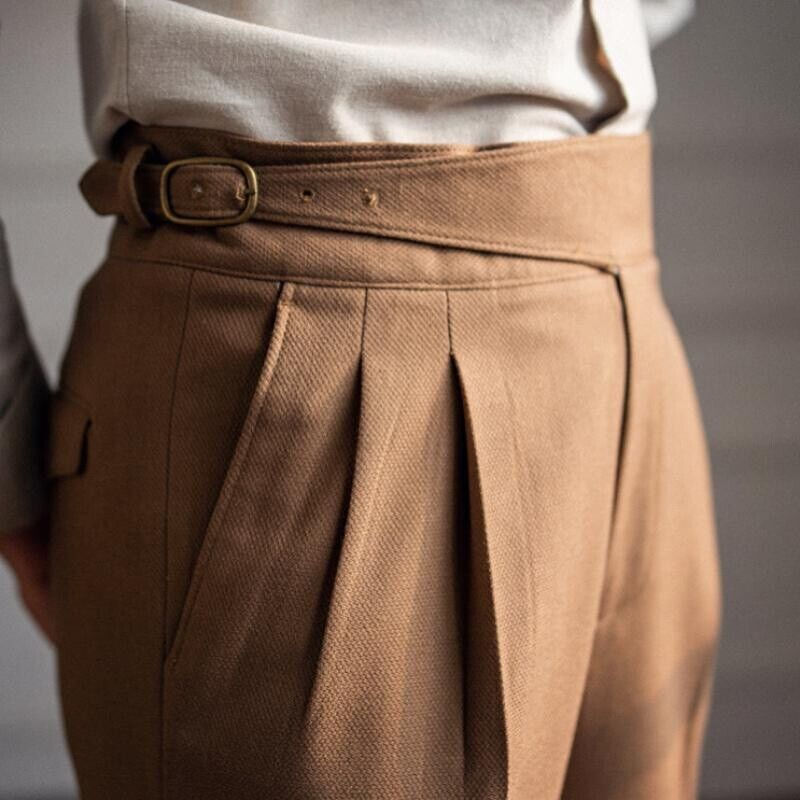Single Pleats, Double Pleats or No Pleats: A Guide to Choosing the Perfect Trouser Style
- Justin Pollheim

- Dec 5, 2024
- 3 min read
Pleats might seem like a small detail, but they play a big role in the fit, comfort, and overall look of a pair of trousers. Whether you're choosing single pleats, double pleats, or no pleats (flat fronts), understanding their function and style is essential in creating a polished outfit. This guide delves into these three options, helping you determine which suits your needs best.
What Are Pleats in Tailoring?
Pleats are folds of fabric sewn into the waistline of trousers. They allow extra room for movement, making trousers more comfortable and versatile. Pleats can enhance the appearance of trousers, adding texture and depth, or they can be omitted altogether for a sleek, modern look.
Single pleats are a versatile choice, providing both style and functionality. These trousers feature one fold of fabric on each side of the front panel.
Benefits: Single pleats are ideal for those who want a tailored appearance without sacrificing comfort. They offer enough room for movement while maintaining a streamlined look.
Style: Perfect for slim or athletic builds, single pleats suit contemporary formalwear or even slightly relaxed styles.
Occasions: Pair single pleats with a fitted blazer for work or semi-formal events. Fabrics like wool or wool blends elevate their look.
Double pleats, as the name suggests, feature two pleats on each side. This style is a hallmark of vintage tailoring, offering maximum comfort and a refined aesthetic.
Benefits: Double pleats provide extra room in the thighs and seat area, making them an excellent choice for those who prioritise ease of movement. They also complement larger or more muscular builds.
Style: Associated with traditional tailoring, double pleats are often seen in suits with broader shoulders and fuller cuts.
Occasions: Ideal for formal settings or occasions where a classic, sophisticated look is desired. Opt for heavier fabrics like tweed or flannel to make the most of this style.
No Pleats (Flat Fronts): Modern Minimalism
Flat-front trousers skip pleats entirely, favouring a clean and slim silhouette. This style has become a staple of modern tailoring.
Benefits: Flat-front trousers hug the body more closely, creating a sharp and contemporary look. They work best for those with slimmer builds.
Style: Popular in casual and semi-formal wear, flat fronts are synonymous with modern minimalism.
Occasions: Wear flat-front trousers with a tailored jacket or a crisp shirt for a sleek look. They're particularly well-suited to warmer climates and lighter fabrics.
How to Choose the Right Style
When choosing between single pleats, double pleats, or flat fronts, consider the following:
Body Shape: Single pleats suit slim to athletic builds; double pleats favour fuller figures; flat fronts are best for lean silhouettes.
Occasion: Double pleats are great for formal events, while single pleats and flat fronts work for versatile or casual settings.
Fabric: Heavier fabrics like tweed or flannel often pair well with pleats, while lighter fabrics like cotton or linen look better with flat fronts.
Conclusion
Pleats are more than a design detail—they're a key component of a trouser's functionality and style. Whether you gravitate towards the modern appeal of flat fronts, the balance of single pleats, or the timeless charm of double pleats, choosing the right pleat style ensures a well-tailored look that complements your wardrobe and lifestyle.











Comments